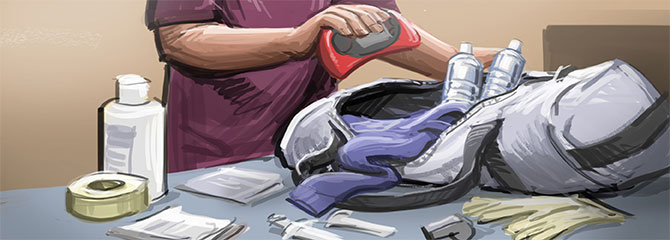Preparedness

Preparedness
Everyone should be prepared for an emergency. But as a person with a bleeding disorder, it’s very important that you be specifically prepared for any kind of emergency. You need your medicine and you need to be able to let emergency workers know you have a bleeding disorder.
Make sure that you know your school and family emergency plan. Always be ready for the unexpected by putting together a go-bag with emergency items and necessary medical supplies.
For more information, go to Family Emergency Kit Checklist.
What’s the Plan?
Sit down with your whole family and discuss your emergency preparedness plan.
Here are some items to consider:
- A meeting spot. Choose one meeting spot where everyone will meet in case you are separated from each other.
- Out-of-town contact. Choose an out-of-town relative whom you will call if your local telephones are not working.
- Program the number in your cell phone, but be sure you have it memorized.
- Practice, practice, practice! Try calling your out-of-town relative or emergency contact using your cell phone and just by memory.
- Emergency contact information. Program your emergency contact number into your cell phone under ICE (In Case of Emergency).
- This way, emergency responders will know who to call if you can’t tell them the number.
- Your parents will know whether your ICE contact should be a doctor or a relative.
- Share emergency plans.
- Share your family emergency plan with your Hemophilia Treatment Center (HTC) team.
- Review your school emergency preparedness plan with your family.
- Try to do this at least once a year.
- Be sure everyone knows the school’s central meeting spot and who to call in case of emergency.
What’s in Your Go-Bag?
A go-bag is filled with important supplies you’ll need in case of an emergency. One person in your family should be responsible for quickly grabbing the bag when you have to evacuate. Be sure everyone in the family knows where the go-bag is kept. Remember, check the bag from time to time to see if any of the items have reached their expiration date and need to be replaced.
Here’s are some recommended items for your go-bag:
- Important telephone numbers
- Hemophilia Treatment Center (HTC)
- Home care company
- Doctors
- Insurance company
- Emergency room
- Out-of-town relative
- Important medical information
- Your diagnosis
- Your factor product and instructions
- Your treatment regimen
- Factor replacement product
- Factor infusion supplies
- Clean cloth for a work area
- Disinfectant/chlorine bleach
- Tourniquet
- Alcohol wipes
- Gloves
- Syringes
- Gauze, tape, and bandages
- Sharps container
- Ice pack
- Treatment log
- Flashlight with extra batteries
- Whistle
- Cell phones and chargers
Test your knowledge, go to the Go-Bag Word Scramble Games.
Be Emergency Ready
The Federal Emergency Management Agency (FEMA) has a great Web site, Ready Kids, which both you and your parents can use to prepare for disasters. FEMA urges you to get a kit, make a plan, and be informed.
On the site you will discover that disasters come in many shapes and sizes. Some, like a hurricane, are predictable. Others, like tornadoes, are not. Finding out about different kinds of disasters helps everyone become well prepared.
Each step of the process includes games and other activities designed to give you a fun way to learn:
- How to create a disaster kit
- What you might feel during and after an incident
- How to keep you and your families safe
The FEMA Web site also has resources for parents and teachers, including curricula or safety information that can be used in the classroom or at home.
